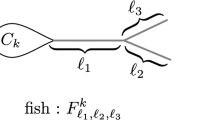Abstract
We consider the problems of minimum-cost design and augmentation of directed network clusters that have diameter 2 and maintain the same diameter after the deletion of up to R elements (nodes or arcs) anywhere in the cluster. The property of a network to maintain not only the overall connectivity, but also the same diameter after the deletion of multiple nodes/arcs is referred to as strong attack tolerance. This paper presents the proof of NP-completeness of the decision version of the problem, derives tight theoretical bounds, as well as develops a heuristic algorithm for the considered problems, which are extremely challenging to solve to optimality even for small networks. Computational experiments suggest that the proposed heuristic algorithm does identify high-quality near-optimal solutions; moreover, in the special case of undirected networks with identical arc construction costs, the algorithm provably produces an exact optimal solution to strongly attack-tolerant two-hop network design problem, regardless of the network size.











Similar content being viewed by others
Notes
The parameter β of the generated power-law graphs was chosen to approximately match the number of arcs in the corresponding uniform graphs with the same number of nodes. This procedure was performed for comparison reasons. It is described in more detail in Veremyev and Boginski (2012a).
References
Balasundaram B, Butenko S, Trukhanov S (2005) Novel approaches for analyzing biological networks. J Comb Optim 10:23–39
Bang-Jensen J, Chiarandini M, Morling P (2010) A computational investigation of heuristic algorithms for 2-edge-connectivity augmentation. Networks 55(4):299–325
Bang-Jensen J, Jordán T (1998) Edge-connectivity augmentation preserving simplicity. SIAM J Discrete Math 11(4):603–623
Bendali F, Diarrassouba I, Mahjoub AR, Mailfert J (2010) The k edge-disjoint 3-hop-constrained paths polytope. Discrete Optim 7(4):222–233
Botton Q, Fortz B, Gouveia L, Poss M (2011) Benders decomposition for the hop-constrained survivable network design problem. INFORMS J Comput. doi:10.1287/ijoc.1110.0472
Conforti M, Galluccio A, Proietti G (2004) Edge-connectivity augmentation and network matrices. In: Hromkovic J, Nagl M, Westfechtel B (eds) WG. Lecture notes in computer science, vol 3353. Springer, Berlin, pp 355–364
IBM ILOG CPLEX optimization studio 12.4 (2011) http://www-01.ibm.com/software/integration/optimization/cplex-optimizer/
Dahl G, Gouveia L (2004) On the directed hop-constrained shortest path problem. Oper Res Lett 32(1):15–22
Dahl G, Huygens D, Mahjoub AR, Pesneau P (2006) On the edge-disjoint 2-hop-constrained paths polytope. Oper Res Lett 34(5):577–582
Dahl G, Johannessen B (2004) The 2-path network problem. Networks 43(3):190–199
Eswaran KP, Tarjan RE (1976) Augmentation problems. SIAM J Comput 5(4):653–665
Fico™ xpress optimization suite 7.1 (2011) http://www.fico.com/en/Products/DMTools/Pages/FICO-Xpress-Optimization-Suite.aspx
Frank A (1992) Augmenting graphs to meet edge-connectivity requirements. SIAM J Discrete Math 5(1):25–53
Frank A (1994) Connectivity augmentation problems in network design. In: Birge J, Murty KG (eds) Mathematical programming: state of the art. University of Michigan Press, Ann Arbor, pp 34–63
Fured Z, Horak P, Pareek CM, Zhu X (1998) Minimal oriented graphs of diameter 2. Graphs Comb 14:345–350
Garey M, Johnson D (1979) Computers and intractability: a guide to the theory of NP-completeness. Freeman, New York
Gouveia L, Patricio P, Sousa A (2008) Hop-constrained node survivable network design: an application to mpls over wdm. Netw Spat Econ 8(1):3–21
Hsu TS (2002) Simpler and faster biconnectivity augmentation. J Algorithms 45(1):55–71
Huygens D, Labbé M, Mahjoub AR, Pesneau P (2007) The two-edge connected hop-constrained network design problem: valid inequalities and branch-and-cut. Networks 49(1):116–133
Huygens D, Mahjoub AR, Pesneau P (2004) Two edge-disjoint hop-constrained paths and polyhedra. SIAM J Discrete Math 18(2):287–312
Ishii T, Nagamochi H (2000) On the minimum augmentation of an l-connected graph to a k-connected graph. In: SWAT, pp 286–299
Li CL, McCormick S, Simchi-Levi D (1992) On the minimum-cardinality-bounded-diameter and the bounded-cardinality-minimum-diameter edge addition problems. Oper Res Lett 11:303–308
Ljubić I (2010) A branch-and-cut-and-price algorithm for vertex-biconnectivity augmentation. Networks 56(3):169–182
Meijer H, Dawes R (1988) Fault tolerant networks of specified diameter. In: van Leeuwen J (ed) WG. Lecture notes in computer science, vol 344. Springer, Berlin, pp 74–86
Mokken RJ (1979) Cliques, clubs and clans. Qual Quant 13(2):161–173
Murty USR (1968) On critical graphs of diameter 2. Math Mag, 138–140
Pirkul H, Soni S (2003) New formulations and solution procedures for the hop constrained network design problem. Eur J Oper Res 148(1):126–140
Schumacher U (1984) An algorithm for construction of a k-connected graph with minimum number of edges and quasiminimal diameter. Networks 14:63–74
Soneoka T, Nakada H, Imase M (1990) Design of a d-connected digraph with a minimum number of edges and a quasiminimal diameter. Discrete Appl Math 27:255–265
Veremyev A, Boginski V (2012a) Identifying large robust network clusters via new compact formulations of maximum k-club problems. Eur J Oper Res 218:316–326
Veremyev A, Boginski V (2012b) Robustness and strong attack tolerance of low-diameter networks. In: Sorokin A, Murphey R, Thai MT, Pardalos PM (eds) Dynamics of information systems: mathematical foundations. Springer, Berlin (to appear)
Author information
Authors and Affiliations
Corresponding author
Additional information
This work was supported in part by the Air Force Research Laboratory (AFRL) and the Defense Threat Reduction Agency (DTRA).
Rights and permissions
About this article
Cite this article
Pastukhov, G., Veremyev, A., Boginski, V. et al. Optimal design and augmentation of strongly attack-tolerant two-hop clusters in directed networks. J Comb Optim 27, 462–486 (2014). https://doi.org/10.1007/s10878-012-9523-6
Published:
Issue Date:
DOI: https://doi.org/10.1007/s10878-012-9523-6




